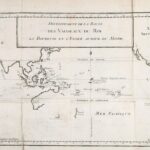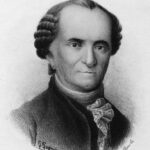Jeanne Baret
Explorer
Modern
Quick Facts:
She was a French botanist and explorer. She unknowingly became the first woman to sail around the entire globe.
Introduction
Jeanne Baret sailed around the world as part of the first French circumnavigation of the globe from 1766 to 1769. At this time, France was looking to expand its economy. So the French government funded hundreds of expeditions to travel around the world. Although Baret initially joined the voyage to assist Philibert Commerson, she studied many new plants and the environments in which they grew. Without knowing, Jeanne Baret became the first woman to circumnavigate the world. It is only in recent years that Baret’s story became a more recognized part of history.
Biography
Early Life
Jeanne Baret was born July 27, 1740 in Autun, France to Jean and Jeanne Baret. Her family was poor. One record indicates that her father was a day laborer who helped with farming and harvesting.1 Since she grew up in a rural area, Baret became skilled at gathering and learning about different plants. Although she had no formal education, Jeanne Baret possessed a strong knowledge of botany at a young age. She became known as an “herb woman” due to her knowledge of botanical (plant) medicine. Years later, Baret was employed as a housekeeper to Philibert Commerson. Commerson studied medicine, natural history, and botany – the study of plants. He had moved close to Jeanne’s hometown to work and collect plant samples.2 It was during this time that Baret and Commerson formed a close friendship.
Commerson became much more personal when Commerson’s wife died in 1762. Baret and Commerson lived together and had a child out of wedlock in 1764. The couple moved to Paris and gave up their baby up for adoption soon after the child was born. Baret continued to act as a housekeeper and eventually a nurse for Commerson. In 1765, Louis-Antoine de Bougainville, a French admiral and explorer, was asked to go discover new territories for France. Bougainville invited Commerson to join him as his botanist. He insisted that his assistant, Jeanne Baret, come along. But the French Navy did not allow women on board ships. In order to avoid this law, Baret dressed herself as boy. Using the name “Jean” Baret, she was hired to work as Commerson’s assistant on the ship called the Étoile.
Voyages
Principal Voyage
Two ships were part of this journey: The Boudeuse and the Étoile which Baret and Commerson sailed on. The Étoile set sail from Nantes, France in 1766. Their goal was to circumnavigate – sail around – the world. One of the first stops made during the journey was in Montevideo, Uruguay. Commerson and Baret collected plant samples and observed the surrounding environment. During this excursion, Commerson was sickly and could not do much so Baret took over a majority of the work. After the stop in Montevideo, the ship sailed on to Rio de Janeiro, Brazil. Again, Commerson and Baret had the opportunity to explore the territory and observe the plants. It is believed that Baret was the one who discovered a strange new flowering vine adorned with bright pink and purple flowers. Baret named the new plant Bougainvillea after the leader of the expedition.3
After successfully sailing through the Strait of Magellan at the tip of South America, the Étoile reached Tahiti in 1767. They encountered beautiful native women. So Bougainville named it New Cythera. In Greek mythology, Cythera was thought to be the birthplace to the goddess of love and beauty.4 Baret was able to hide her true identify from the crew for much of the journey by remaining private and defensive. But in Tahiti Baret’s true identity was revealed. Historians do not know the actual story of how the reveal took place. One account notes that when she went ashore in Tahiti, the Tahitian natives quickly noticed her gender. When taken back aboard the Étoile she confessed to lying and revealed her true identity.5
Subsequent Voyages
Baret continued on the ship from Tahiti to New Ireland – located today in Papua New Guinea. Staying on board as a woman was sometimes dangerous. Some of the crewman wanted their own proof she was a woman. So they attacked Baret to see for themselves while she was out studying shells.6 After this, Baret did not go ashore very often. In 1768, the ship stopped in Mauritius, an island in the Indian Ocean, to restock its supplies. When the Étoile and Boudeuse were ready to head back to France, Baret and Commerson did not join them. They remained on Mauritius.
Later Years and Death
Commerson and Baret stayed on Mauritius as guests of Pierre Poivre, governor of the island. While living on Mauritius, Baret continued to act as Commerson’s housekeeper and nurse until his death in 1773. Baret remained in Mauritius until she returned to France. At some point, she met a French soldier named Jean Dubernat. They married in May 1774.7 When Jeanne Baret returned to France in 1774 (possibly early 1775) she completed her circumnavigation around the world. They moved to Dubernat’s hometown of in Saint-Aulaye where she remained until her death. Jeanne Baret died in Saint-Aulaye, France on August 5, 1807 at the age of 67.8
Legacy
Jeanne Baret’s achievement for being the first woman to circumnavigate the world was not always fully recognized. Her work and collections of exotic plants are still important information today. Baret herself did not record her experiences during the voyage. Travel logs from several crew members, though, reveal the hardships that she dealt with when her true identity was revealed. But the writing’s left behind by Bougainville and Commerson detail not only what she endured, but what she accomplished. In one translation of Commerson’s notes, he credits Baret for being the first female to circle the globe. He continues to say that she should be honored for her records on the plants and other specimen she collected.9 Even though Jeanne Baret did not intend to be the first woman to circumnavigate the globe, we openly recognize her achievement.
Endnotes
- Glynis Ridley, The Discovery of Jeanne Baret: A Story of Science, the High Seas, and the First Woman to Circumnavigate the Globe (New York: Broadway Paperbacks, 2010), 13.
- Debbie Foulkes, “Jeanne Baret (1740 – 1807) First Woman to Circumnavigate the Globe,” February 7, 2011, https://forgottennewsmakers.com/2011/02/07/jeanne-baret-1740-%E2%80%93-1807-first-woman-to-circumnavigate-the-globe/.
- Robert Krulwich, “The First Woman To Go ‘Round The World Did It As A Man,” NPR, January 24, 2012, http://www.npr.org/sections/krulwich/2012/01/23/145664873/the-first-woman-to-go-round-the-world-did-it-as-a-man.
- Ridley, The Discovery of Jeanne Baret, 156.
- Christian Lamb, From the Ends of the Earth: Passionate Plant Collectors Remembered in a Cornish Garden (London: Bene Factum Publishing Ltd., 2004), 101.
- Ridley, The Discovery of Jeanne Baret, 189.
- Ridley, The Discovery of Jeanne Baret, 232.
- Ridley, The Discovery of Jeanne Baret, 241.
- Lamb, From the Ends of the Earth, 102.
Bibliography
Foulkes, Debbie. “Jeanne Baret (1740 – 1807) First Woman to Circumnavigate the Globe,. February 7, 2011. https://forgottennewsmakers.com/2011/02/07/jeanne-baret-1740-%E2%80%93-1807-first-woman-to-circumnavigate-the-globe/.
Krulwich, Robert. “The First Woman To Go ‘Round The World Did It As A Man.” NPR. January 24, 2012. http://www.npr.org/sections/krulwich/2012/01/23/145664873/the-first-woman-to-go-round-the-world-did-it-as-a-man.
Lamb, Christian. From the Ends of the Earth: Passionate Plant Collectors Remembered in a Cornish Garden. London: Bene Factum Publishing Ltd., 2004.
Ridley, Glynis. The Discovery of Jeanne Baret: A Story of Science, the High Seas, and the First Woman to Circumnavigate the Globe. New York: Broadway Paperbacks, 2010.
Gallery






